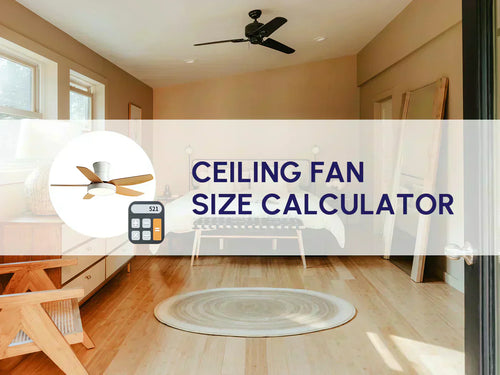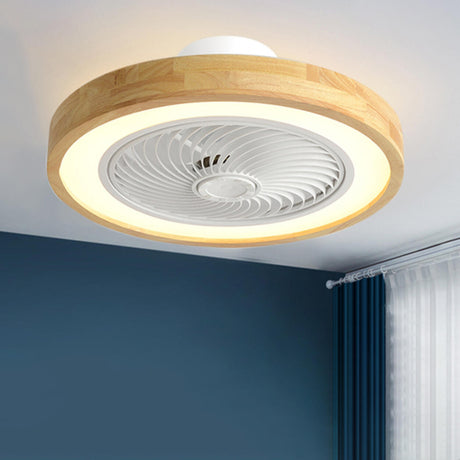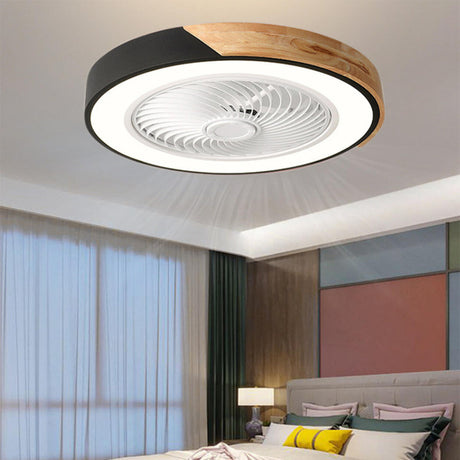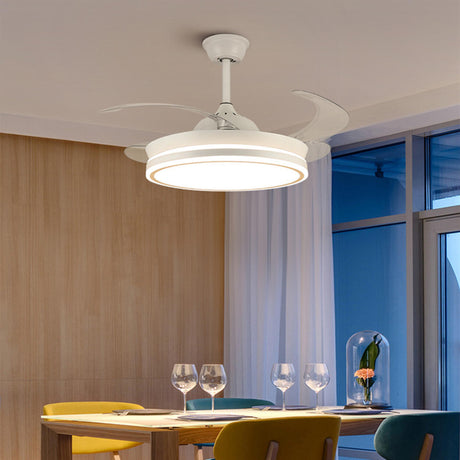CFM tells you how much air your fan moves. Too little CFM = hot and sticky even on high speed. Too much CFM = annoying drafts and wasted energy.
This guide covers the real ceiling fan CFM you need, room by room. No confusing math - just practical advice to pick a fan that actually works.
Table of Contents
1. What is the Ceiling Fan CFM?
Ceiling Fan CFM stands for Cubic Feet per Minute. It measures how much air a ceiling fan moves in one minute. Higher CFM equals better airflow and cooler rooms. It's one of the key numbers to check when choosing a ceiling fan.
2. Ceiling Fan CFM Calculator
To make this process easier, we've created a simple tool that does the hard work for you.
Ceiling Fan CFM Calculator
Get the perfect airflow for your room in seconds
Your CFM Requirements
Ceiling fan CFM quick chart
Looking for the ideal ceiling fan CFM for room size? This chart gives you a fast reference.
| Room Type / Size (Square Feet) | Ceiling Fan Diameter (Inches) | Airflow (CFM) | Ideal For |
| Small Rooms (Up to 100 sq. ft.) | 29" - 42" | 1,000 - 3,000 CFM | Bathrooms, home offices, laundry rooms, and walk-in closets. |
| Medium Rooms(100 - 225 sq. ft.) | 44" - 52" | 2,000 - 5,000 CFM | Most standard bedrooms, kitchens, and dining areas. |
| Standard / Large Rooms(225 - 400 sq. ft.) | 52" - 56" | 4,000 - 8,000 CFM | Living rooms, master bedrooms, and family rooms. |
| Great Rooms & Lofts(Over 400 sq. ft.) | 60" or larger | 6,000 - 14,000+ CFM | Large, open-plan spaces, rooms with high ceilings (over 9 ft.), and commercial areas. |
Key factors to consider
A few important adjustments to keep in mind:
High/Sloped Ceilings: For ceilings over 10 feet, choose fans with higher CFM ratings within your room size range. For sloped or cathedral ceilings, use the average height, not the peak height in your calculation.
Heavy Room Use: Add 20-30% more CFM for frequently occupied spaces like family rooms or home offices.
Poor HVAC Coverage: Rooms with limited central air may need higher CFM to compensate.
Fan size also plays an important role in overall airflow. Larger rooms usually need bigger fan diameters, but there's no one-size-fits-all rule. For accurate sizing based on your room dimensions, use our Ceiling Fan Size Calculator.
3. Ceiling Fan CFM for Different Rooms
Different rooms in your home have unique airflow challenges and comfort requirements.
Living rooms and family rooms ceiling fan CFM
Living rooms vary widely in size, so airflow needs change accordingly. Here are recommended CFM ranges for typical living room sizes with 8-9 ft ceilings:
| Room Size | Fan Size | CFM Range | Notes |
| 200 sq ft | 44" - 52" | 2,500 - 4,000 CFM | Standard living room |
| 300 sq ft | 52" - 56" | 4,000 - 6,500 CFM | Large living room |
| 400+ sq ft | 56" - 60"+ | 6,000 - 10,000+ CFM | Great room/open concept |
For open spaces like combined living-dining-kitchen areas over 600 sq ft, using two medium fans (each providing 4,000-5,000 CFM) works better than one large fan for even airflow distribution.
Bedroom ceiling fan CFM
Wondering how much airflow your bedroom really needs? This quick breakdown helps you match the right ceiling fan CFM for bedroom size-whether it's a compact guest room or a spacious master suite.
| Bedroom Type | Room Size | Fan Size | CFM Range |
| Small bedroom | 80-120 sq ft | 36" - 42" | 1,500 - 2,500 CFM |
| Standard bedroom | 120-200 sq ft | 44" - 48" | 2,500 - 4,000 CFM |
| Master bedroom | 200-300 sq ft | 52" - 56" | 4,000 - 6,500 CFM |
Example: A 14×16 master bedroom (224 sq ft) would need a 52" fan providing approximately 4,000-5,000 CFM for optimal comfort.
Kitchen and dining areas

Open Kitchens: Benefit from ceiling fans to manage cooking heat and odors. Most standard kitchens (120-150 sq ft) work well with 44"-48" fans providing 2,500-3,500 CFM. For combined kitchen-dining areas, you might need 5,000-7,000 CFM total.
Enclosed Kitchens: Need higher airflow to handle moisture and heat buildup. A typical 10×12 enclosed kitchen (120 sq ft) requires a 44" fan with 3,000-4,000 CFM. Place fans away from stovetops to avoid interfering with range hood operation.
Dining Rooms: Work best with fans positioned to avoid direct airflow over the table. For a 12×14 dining room (168 sq ft), a 48" fan providing 3,000-4,000 CFM works well. Breakfast nooks and smaller dining spaces do well with 42" fans providing 2,000-2,500 CFM.
4. Special Ceiling CFM Recommendations

Rooms with high or angled ceilings need extra attention to ensure proper airflow.
High ceilings (10+ Feet)
High ceilings create unique airflow challenges that affect CFM requirements.
For ceilings 10-12 feet: Choose CFM at the higher end of your room size range. For ceilings above 12 feet, consider fans with 20-30% more CFM than standard recommendations.
Additionally, install fans with long downrods to position them 8-10 feet above the floor for optimal airflow.
Sloped or cathedral ceilings
Sloped ceilings complicate both CFM calculations and fan installation. Air circulation patterns change significantly compared to flat ceilings.
CFM Selection Method: Base your CFM choice on room square footage, but select fans at the higher end of the recommended range.
Example: A 16×20 room (320 sq ft) with a sloped ceiling should use a 56" fan with 6,000-8,000 CFM.
Special Considerations:
- Install a fan at the room's center, not the ceiling's highest point
- Position fan 7-9 feet above floor level for optimal circulation
- Use angled mounting kits to ensure proper blade clearance
- Consider multiple fans for rooms longer than 20 feet
CFM Distribution: Distribute airflow across multiple smaller fans rather than relying on one large unit. This prevents dead air zones in lower ceiling areas.
5. Home Fan Troubleshooting Guide
Identifying insufficient ceiling fan CFM symptoms.
Hot spots and uneven temperatures
If your fan isn't providing consistent comfort throughout the room, you're likely dealing with insufficient airflow. The most common indicators include:
- Noticeable temperature variations (3-4°F difference) within the same space
- Certain areas (like corners or near windows) remain stuffy
- Upper floors are staying significantly warmer than lower levels
The solution depends on your room size. For smaller rooms (under 200 sq ft), increasing your fan's speed setting may help. Larger spaces often require either upgrading to a higher-CFM fan or adding a second unit. Remember that fans should be centered over primary seating or sleeping areas.
Poor air quality indicators
Stale, stagnant air isn't just uncomfortable-it can negatively impact your health. Common signs of poor air quality include lingering cooking odors, excessive dust buildup, and persistent humidity in bathrooms. To improve ventilation, ensure enclosed kitchens have fans rated at 3,000 to 4,000+ CFM, while living areas may require 3,000 to 5,000+ CFM depending on size. Upgrading to a fan with 20-30% more airflow capacity can enhance performance. Also, make sure the fan is running at an appropriate speed, as operating it too slowly won't circulate air effectively.
Energy efficiency red flags
When your ceiling fan isn't performing optimally, your HVAC system has to work harder, leading to:
- Unexpected spikes in energy bills
- Constant AC or heater operation without reaching the desired temperatures
- Frequent system cycling on and off
To address this, first confirm your fan's rotation direction - it should run counterclockwise in summer and clockwise in winter. DC motor fans offer superior energy efficiency, using up to 70% less power than AC models. Also check that your fan blades are clean and properly balanced, as dust buildup can reduce efficiency by up to 30%.
For best results, combine these troubleshooting steps with regular maintenance. Clean fan blades monthly, tighten any loose components, and consider professional servicing for hard-to-reach installations.
Conclusion
The right CFM for your ceiling fan ensures proper airflow and comfort. Choose based on your room size using our recommended CFM ranges - every room is different, and a setup that works well in your living room might not be ideal for your bedroom or kitchen. Measure your space carefully and select fans within the appropriate CFM range for your room size. With the right CFM selection, you can boost air circulation, save on energy bills, and feel confident in your home upgrade choices.
FAQ
Does higher CFM mean better cooling?
Does higher CFM mean better cooling?
Not always. Higher CFM means more airflow, but that doesn’t always lead to better comfort. If the fan is too strong for the room, it can cause drafts and feel too intense. The key is to match the CFM to your room size and needs, aiming for balance instead of just the highest number.
How do I know if my ceiling fan's CFM is enough?
How do I know if my ceiling fan's CFM is enough?
Notice how the room feels. If some spots feel stuffy, temperatures vary a lot, or odors stay around, your fan might not be moving enough air. You can also check the fan’s specs and compare them with recommended CFM for your room size. Using a CFM calculator makes this quick and simple.
Does CFM drop over time?
Does CFM drop over time?
Yes, it can. Dust on blades or motor, worn parts, or lack of maintenance can reduce fan performance and lower effective CFM. Regular cleaning and occasional checkups help keep airflow strong and extend your fan’s lifespan.












